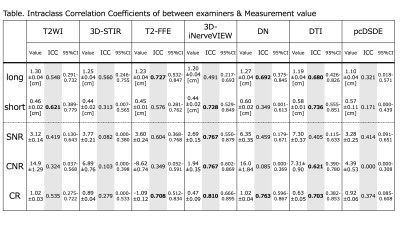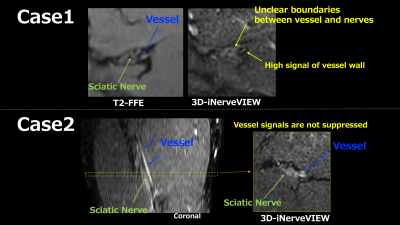Ryuna Kurosawa1, Hajime Yokota2, Takafumi Yoda1, Takayuki Sada1, Koji Matsumoto1, Takashi Namiki3, Masami Yoneyama3, Yoshitada Masuda1, and Takashi Uno2
1Department of Radiology, Chiba University Hospital, Chiba, Japan, 2Diagnostic Radiology and Radiation Oncology, Graduate School of Medicine, Chiba University, Chiba, Japan, 3Philips Japan, Tokyo, Japan
1Department of Radiology, Chiba University Hospital, Chiba, Japan, 2Diagnostic Radiology and Radiation Oncology, Graduate School of Medicine, Chiba University, Chiba, Japan, 3Philips Japan, Tokyo, Japan
To evaluate inter-rater reliability of sciatic nerve evaluation with various MRN sequences. 3D-iNerveVIEW had high inter-rater reliability for signal measurements. For MRN measurements, it is important to understand the characteristics of each sequence.

Figure 4. Intraclass coefficient correlations between two examiners for the sciatic nerve size and signal measurements. Bold represents ICC> 0.601. T2-FFE, DN, and DTI show substantial agreements in the long diameter, while T2WI, 3D-iNerveVIEW, and DTI show substantial agreements in the short diameter. Regarding the signal measurements, 3D-iNerveVIEW shows substantial to almost perfect agreements in signal-to-noise ratio (SNR), contrast-to-noise ratio (CNR), and contrast ratio (CR).

Figure 5. Problems with 3D-iNerveVIEW. Case1: By suppressing the signal of the vessel, the boundary between nerves and blood vessels becomes unclear. In addition, the vessel walls running in parallel in the long diameter direction of the sciatic nerve become high signals, which reduces visibility. Case2: The vessels are misidentified and measured as nerves when the signal of the vessels running parallel to the long diameter of the sciatic nerve cannot be suppressed.